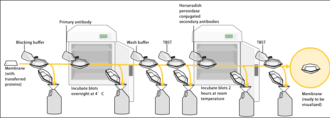Western blot






Western blot (also known as protein immunoblot) is a widely used analytical technique in molecular biology and immunogenetics to detect specific proteins in a sample of tissue homogenate or extract. The method uses gel electrophoresis to separate native or denatured proteins by the length of the polypeptide (denaturing conditions) or by the 3-D structure of the protein (native/non-denaturing conditions). The proteins are then transferred to a membrane (typically PVDF or nitrocellulose), where they are stained with antibodies specific to the target protein.
Procedure[edit]
The Western blot procedure involves several steps:
- Sample preparation: The protein samples are prepared by mixing with a SDS-PAGE loading buffer and possibly heating.
- Gel electrophoresis: The proteins are separated based on their size through SDS-PAGE.
- Transfer: The proteins are transferred from the gel onto a membrane, making them more accessible for analysis.
- Blocking: The membrane is incubated with a solution of protein (such as non-fat dry milk) to block nonspecific binding sites.
- Antibody incubation: The membrane is incubated with a primary antibody specific to the target protein. Then, after washing, it is incubated with a secondary antibody conjugated to a reporter enzyme or dye.
- Detection: The enzyme or dye is activated, producing a signal that can be detected by various methods, indicating the presence and quantity of the target protein.
Applications[edit]
Western blotting is used in both scientific research and medical diagnostics. In research, it helps in identifying specific proteins in a complex mixture and studying protein expression under various conditions. In diagnostics, it is employed for the detection of antibodies in diseases like HIV, Lyme disease, and Hepatitis B.
Advantages and Limitations[edit]
The main advantage of Western blotting is its specificity; it can detect a single protein in a mixture of thousands of proteins. However, it is a time-consuming process and requires a significant amount of technical skill to perform accurately. Additionally, quantification can be challenging and less precise compared to other methods like ELISA.
See Also[edit]
Ad. Transform your life with W8MD's Budget GLP-1 injections from $75


W8MD offers a medical weight loss program to lose weight in Philadelphia. Our physician-supervised medical weight loss provides:
- Weight loss injections in NYC (generic and brand names):
- Zepbound / Mounjaro, Wegovy / Ozempic, Saxenda
- Most insurances accepted or discounted self-pay rates. We will obtain insurance prior authorizations if needed.
- Generic GLP1 weight loss injections from $75 for the starting dose.
- Also offer prescription weight loss medications including Phentermine, Qsymia, Diethylpropion, Contrave etc.
NYC weight loss doctor appointmentsNYC weight loss doctor appointments
Start your NYC weight loss journey today at our NYC medical weight loss and Philadelphia medical weight loss clinics.
- Call 718-946-5500 to lose weight in NYC or for medical weight loss in Philadelphia 215-676-2334.
- Tags:NYC medical weight loss, Philadelphia lose weight Zepbound NYC, Budget GLP1 weight loss injections, Wegovy Philadelphia, Wegovy NYC, Philadelphia medical weight loss, Brookly weight loss and Wegovy NYC
|
WikiMD's Wellness Encyclopedia |
| Let Food Be Thy Medicine Medicine Thy Food - Hippocrates |
Medical Disclaimer: WikiMD is not a substitute for professional medical advice. The information on WikiMD is provided as an information resource only, may be incorrect, outdated or misleading, and is not to be used or relied on for any diagnostic or treatment purposes. Please consult your health care provider before making any healthcare decisions or for guidance about a specific medical condition. WikiMD expressly disclaims responsibility, and shall have no liability, for any damages, loss, injury, or liability whatsoever suffered as a result of your reliance on the information contained in this site. By visiting this site you agree to the foregoing terms and conditions, which may from time to time be changed or supplemented by WikiMD. If you do not agree to the foregoing terms and conditions, you should not enter or use this site. See full disclaimer.
Credits:Most images are courtesy of Wikimedia commons, and templates, categories Wikipedia, licensed under CC BY SA or similar.
Translate this page: - East Asian
中文,
日本,
한국어,
South Asian
हिन्दी,
தமிழ்,
తెలుగు,
Urdu,
ಕನ್ನಡ,
Southeast Asian
Indonesian,
Vietnamese,
Thai,
မြန်မာဘာသာ,
বাংলা
European
español,
Deutsch,
français,
Greek,
português do Brasil,
polski,
română,
русский,
Nederlands,
norsk,
svenska,
suomi,
Italian
Middle Eastern & African
عربى,
Turkish,
Persian,
Hebrew,
Afrikaans,
isiZulu,
Kiswahili,
Other
Bulgarian,
Hungarian,
Czech,
Swedish,
മലയാളം,
मराठी,
ਪੰਜਾਬੀ,
ગુજરાતી,
Portuguese,
Ukrainian


